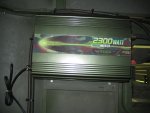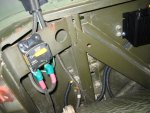Looks like, based on this, and without help of solar panels, these inverters will not power as long as one would hope for.
A low power draw laptop will run for about 8 hours.
A small space heater in a M109 would not last through the night. (Requires 4 batteries)
Here is some helpful info on inverter and battery draw I captured off the internet by a battery seller:
[FONT=Arial,Helvetica][SIZE=+2]Inverter Applications with Optima Deep Cell AGM Batteries [/SIZE][/FONT]
[FONT=Arial, Helvetica, sans-serif]
Power inverters are solid state devices that convert DC battery current to AC line current for portable powering of 120V AC devices of all types. [/FONT]
[FONT=Arial, Helvetica, sans-serif]Optima deep cycle batteries are the ultimate portable power source for use with inverters because of their extreme shock resistance, tolerance of repeated deep discharge cycles, and zero acid leakage. Plus, the Optima's design prevents off-gassing in normal operation, eliminating the corrosion of both connectors and surrounding components that's typical of conventional batteries. [/FONT]
[FONT=Arial, Helvetica, sans-serif]Inverters are available in various maximum-watt ratings. The table below shows estimated wattage consumption for various appliances. Be sure to purchase an inverter with a maximum rating no less than the total of your appliance(s.) If you know the amperage rating of your appliance but do not know the wattage, you can calculate the wattage with the formula: Volts x Amps = Watts. An example: A 120V appliance that runs at 10 amps will consume 1200 watts. You need to add about 15% to that, because the inverter itself will consume a bit of power. 15% more than 1200 watts is 1380 watts. To run three such appliances at the same time, you would need an inverter rated for 4140 watts or more, so a 5000 watt inverter would be a good choice.[/FONT]
[FONT=Arial, Helvetica, sans-serif](Below the table we explain how to determine the size and number of batteries you will need to power your inverter.)[/FONT]
[FONT=Arial, Helvetica, sans-serif]Appliance[/FONT]
[FONT=Arial, Helvetica, sans-serif]Estimated Watts[/FONT]
[FONT=Arial, Helvetica, sans-serif]Appliance[/FONT]
[FONT=Arial, Helvetica, sans-serif]Estimated Watts[/FONT]
[FONT=Arial, Helvetica, sans-serif]Cell Phone[/FONT]
[FONT=Arial, Helvetica, sans-serif]25[/FONT]
[FONT=Arial, Helvetica, sans-serif]
Table Fan [/FONT]
[FONT=Arial, Helvetica, sans-serif]25[/FONT]
[FONT=Arial, Helvetica, sans-serif]Cell Phone Charger [/FONT]
[FONT=Arial, Helvetica, sans-serif]25[/FONT]
[FONT=Arial, Helvetica, sans-serif]Toaster[/FONT]
[FONT=Arial, Helvetica, sans-serif]1200[/FONT]
[FONT=Arial, Helvetica, sans-serif]VCR[/FONT]
[FONT=Arial, Helvetica, sans-serif]40[/FONT]
[FONT=Arial, Helvetica, sans-serif]Circular Saw[/FONT]
[FONT=Arial, Helvetica, sans-serif]1250[/FONT]
[FONT=Arial, Helvetica, sans-serif]Laptop Computer [/FONT]
[FONT=Arial, Helvetica, sans-serif]50-90[/FONT]
[FONT=Arial, Helvetica, sans-serif]Jigsaw[/FONT]
[FONT=Arial, Helvetica, sans-serif]350[/FONT]
[FONT=Arial, Helvetica, sans-serif]Desktop Computer & Monitor [/FONT]
[FONT=Arial, Helvetica, sans-serif]400[/FONT]
[FONT=Arial, Helvetica, sans-serif]1/2" Drill [/FONT]
[FONT=Arial, Helvetica, sans-serif]700[/FONT]
[FONT=Arial, Helvetica, sans-serif]Printer[/FONT]
[FONT=Arial, Helvetica, sans-serif]75[/FONT]
[FONT=Arial, Helvetica, sans-serif]Refrigerator[/FONT]
[FONT=Arial, Helvetica, sans-serif]400[/FONT]
[FONT=Arial, Helvetica, sans-serif]17" TV[/FONT]
[FONT=Arial, Helvetica, sans-serif]75[/FONT]
[FONT=Arial, Helvetica, sans-serif]Vacuum Cleaner [/FONT]
[FONT=Arial, Helvetica, sans-serif]650[/FONT]
[FONT=Arial, Helvetica, sans-serif]CPAP Breathing Machine [/FONT]
[FONT=Arial, Helvetica, sans-serif]200[/FONT]
[FONT=Arial, Helvetica, sans-serif]Sump Pump [/FONT]
[FONT=Arial, Helvetica, sans-serif]1000[/FONT]
[FONT=Arial, Helvetica, sans-serif]Blender[/FONT]
[FONT=Arial, Helvetica, sans-serif]400[/FONT]
[FONT=Arial, Helvetica, sans-serif]CD Player[/FONT]
[FONT=Arial, Helvetica, sans-serif]40[/FONT]
[FONT=Arial, Helvetica, sans-serif]Space Heater [/FONT]
[FONT=Arial, Helvetica, sans-serif]1000[/FONT]
[FONT=Arial, Helvetica, sans-serif]Iron[/FONT]
[FONT=Arial, Helvetica, sans-serif]1000[/FONT]
[FONT=Arial, Helvetica, sans-serif]Coffee Pot [/FONT]
[FONT=Arial, Helvetica, sans-serif]200[/FONT]
[FONT=Arial, Helvetica, sans-serif]Satellite Dish [/FONT]
[FONT=Arial, Helvetica, sans-serif]75[/FONT]
[FONT=Arial, Helvetica, sans-serif]Microwave Oven [/FONT]
[FONT=Arial, Helvetica, sans-serif]1250[/FONT]
[FONT=Arial, Helvetica, sans-serif]PS2 / XBox [/FONT]
[FONT=Arial, Helvetica, sans-serif]125[/FONT]
[FONT=Arial, Helvetica, sans-serif]
Lights, 100 Watt Incandescent [/FONT]
[FONT=Arial, Helvetica, sans-serif]100[/FONT]
[FONT=Arial, Helvetica, sans-serif]
iPod[/FONT]
[FONT=Arial, Helvetica, sans-serif]120[/FONT]
[FONT=Arial, Helvetica, sans-serif]
Lights, Compact Fluorescent, 100 Watt Equivalent [/FONT]
[FONT=Arial, Helvetica, sans-serif]30[/FONT]
[FONT=Arial, Helvetica, sans-serif]
Hot Plate [/FONT]
[FONT=Arial, Helvetica, sans-serif]1200[/FONT]
[FONT=Arial, Helvetica, sans-serif](Ratings are representative of the various appliance types. Use actual ratings of your appliances for best results.) [/FONT]
[FONT=Arial, Helvetica, sans-serif]After determining the size of inverter needed, you need to determine the size of battery (or batteries) required for the running time you want. The storage capacity of batteries is measured in "amp hours" (abbreviated "AH".) The definition of "amp hour" is the ability to provide 1 amp of power for 1 hour. To convert from total watts of load to AH, first use the formula Watts ÷ Volts = Amps. That will tell you the continuous amperage rating of your load. Then multiply that times the number of hours you want to run, and you have the required "amp hours" required from your batteries. [/FONT]
[FONT=Arial, Helvetica, sans-serif]Example: Looking at the table above, you'll see that a laptop computer might require about 70 watts of power (at 120 volts.) So we first multiply 70 watts x 1.15 (to add 15% for the consumption of the inverter) and get 80 watts. Dividing 80 watts by 120 volts = .67 amps of constant load. A mid-size Optima deep cycle battery like the model D34 is rated 55 AH (amp hours) @ 12 volts. Because the inverter will be converting the battery's 12V current to 120V (which is greater by a factor of 10), we divide the battery's 55AH rating by that same factor of 10, and the result is that the D34 battery has a rating of 5.5AH @ 120V. If we then divide that 5.5AH battery rating by the laptop's consumption of .67 amps, we see that the Optima D34 deep cycle battery will run the laptop for 8.2 hours through an inverter. [/FONT]
[FONT=Arial, Helvetica, sans-serif]Here's another example: Suppose you're setting up a booth at an outdoor fair and want to run a laptop (70W), which you want to operate continuously, plus a printer that will run 10% of the time (75W x 10% = 7.5W), a table fan (25W) and a 17" TV (75W). Adding those loads together and then adding 15% gives us a total continuous rating of 204 watts. Dividing 204 watts by 120 volts = 1.7 amps of constant load. The D31-series batteries are Optima's largest deep cycle batteries, rated at 75AH @ 12V. Dividing by 10 for the conversion to 120 volts produces a rating, per battery, of 7.5AH @ 120V. If we divide 7.5AH by the combined fair-going load of 1.7 amps, we see that a D31-series battery will operate all the equipment, through an inverter, for 4.4 hours. Connecting two of the D31-series batteries together in parallel would give you 8.8 hours of running time. Optima makes three variations of the D31-series batteries: The D31A with standard automotive top posts, the D31T with 3/8" threaded stainless steel top studs, and the D31M which has both automotive posts and stainless studs on top. Each is rated 75AH @ 12V. [/FONT]




